Weeks 1-4: November 2007
|
|
| THIS MONTH | THIS WINTER | 2007 TOTAL | SITE TOTAL | |
|---|---|---|---|---|
| # birds (and species) banded | – | – | 3660 (87) | 12978 (103) |
| # birds (and species) repeat | – | – | 677 (49) | 2226 (59) |
| # birds (and species) return | – | – | 131 (24) | 331 (29) |
| # species observed | 36 | 36 | 165 | 191 |
| # net hours | – | – | 7923 | 21945.8 |
| # birds banded / 100 net hours | – | – | 46.2 | 59.1 |
Note: table does not include nocturnal banding (owls).
Banders-in-charge: Marie-Anne Hudson Censusers: Gay Gruner, Barbara and Don MacDuff, Chris Murphy, Greg Rand
Notes: Though this winter’s activities have had to be cut back due to funding and time constraints, we’ve still managed to keep tabs on our feathered friends by running weekly censuses throughout November. Some species finally appeared after being ‘missed’ during our fall season: Bohemian Waxwing and Snow Goose (both lone birds, the Snow Goose a blue phase hidden within a flock of Canada Geese).
Other interesting observations: a plucky little muskrat preening itself along the pond, a coyote trotting along the fence line, a male white-tailed deer finally allowing itself to be seen, and a Merlin happily munching a European Starling not 5 metres from the census trail.
Here’s hoping December, with all its snow, will bring in some special Holiday birds! Large numbers of northern finches are moving south this winter across much of eastern North America, and we hope that some of these (and maybe even some owls too) will put in appearances in the months ahead.
Weeks 5-9: December 2007
|
|
| THIS MONTH | THIS WINTER | 2007 TOTAL | SITE TOTAL | |
|---|---|---|---|---|
| # birds (and species) banded | – | – | 3660 (87) | 12978 (103) |
| # birds (and species) repeat | – | – | 677 (49) | 2226 (59) |
| # birds (and species) return | – | – | 131 (24) | 331 (29) |
| # species observed | 16 | 37 | 165 | 191 |
| # net hours | – | – | 7923 | 21945.8 |
| # birds banded / 100 net hours | – | – | 46.2 | 59.1 |
Note: table does not include nocturnal banding (owls).
Bander-in-charge:Marie-Anne Hudson Censusers: Brian Bell, Barbara Frei
Notes: This December was one of the snowiest we can remember, greatly reducing 1) the number of birds around (we haven’t put out feeders this year since we’re not there enough to ensure they’re always well-stocked, and there’s nothing worse than setting up a bird’s expectations only to fail it when it gets really cold and it needs the boost of easy energy), and 2) the number of times we could walk the census route. So it’s not surprising to see such a low number of species spotted on census. The only new species for this winter was actually only heard: a Brown Creeper twinkling away in the forest.
A possible record that we’re pretty sure we set this December has nothing to do with birds, but with the amount of snow: every census was run on snowshoes! One of the many great things about snow, aside from a great workout, is that it allows you to notice things you may not ordinarily take note of. For example, MBO is home to lots of birds during the breeding season, but birds’ nests are designed to be as difficult to find as possible. In the winter, when fresh snow has fallen and gotten caught in a bird’s nest, it creates a big mound of white amidst bare branches. This makes it very easy to spot, and since you don’t have to worry about disturbing an incubating parent, you can permit yourself the time to really look at the nest to see what it’s made of and how it’s put together. A fascinating pastime!
It’s also great to try to figure out what all the critters have been up to in the absence of human activities. During one census, we noticed a large hole off the side of the trail and paused. As if in response, a massive grey squirrel stuck its head out, clucked and ran right at us! Luckily it decided that this was not a great idea and veered off into a nearby tree, where it continued to look at us balefully. Many other mammals have been active as well, evidenced by their tracks: white-tailed deer, red squirrel, voles and mice.
We promise the January update will have more bird-related notes, but for now we would like to wish you all a wonderful new year, filled with friends and family (and birds of course)
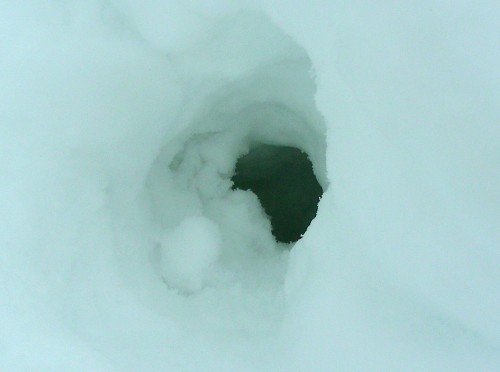
Unfortunately, we waited just a second too long before snapping this picture. Had we been faster, the head of a large grey squirrel would have taken up the entire hole. Who knew grey squirrels burrowed in the snow?! (Photo by Marie-Anne Hudson)
Weeks 10-13: January 2008
PICTURE OF THE MONTH:
|
|
| THIS MONTH | THIS WINTER | 2008 TOTAL | SITE TOTAL | |
|---|---|---|---|---|
| # birds (and species) banded | – | – | – | 12978 (103) |
| # birds (and species) repeat | – | – | – | 2226 (59) |
| # birds (and species) return | – | – | – | 331 (29) |
| # species observed | 13 | 39 | 13 | 191 |
| # net hours | – | – | – | 21945.8 |
| # birds banded / 100 net hours | – | – | – | 59.1 |
Note: table does not include nocturnal banding (owls)
Banders-in-charge: Marie-Anne Hudson Censusers: Natalia Castellanos, Amélie Constantineau, Shawn Craik, Kathleen Earl, Barbara Frei, Demetrios Kobiliris, Barbara and Don MacDuff, Sabrina Richard-Lalonde
Notes: This January has been a mess weather-wise: warm, cold, snow, rain, ice pellets, sunshine, windy, calm. This month has run the gamut of foul weather, reducing the number of nice census days. We’re hoping that the foul weather will play itself out completely, leaving spring beautiful, warm, and perfect for banding!
New species for this winter include Common Raven and Cedar Waxwing. In terms of new species for the year, well they’re all new! We start 2008 with 13 species, including: Red-tailed Hawk, Downy and Hairy Woodpecker, Blue Jay, American Crow, Common Raven, Black-capped Chickadee, White-breasted Nuthatch, American Robin, Cedar Waxwing, European Starling, Northern Cardinal and American Goldfinch.
We’ve put up a few feeders near the gate (in the clearing just up the hill) since the McGill Ethology class had a good amount of leftover seed from a behavioural lab they were conducting. We thank them for their generosity, as do the birds. Please feel free to go have a look to see what’s there, and let us know if the seed level is getting low – we’re hoping to have enough to get through the winter.
Weeks 14-17: February 2008
PICTURE OF THE MONTH:
|
|
| THIS MONTH | THIS WINTER | 2008 TOTAL | SITE TOTAL | |
|---|---|---|---|---|
| # birds (and species) banded | – | – | – | 12978 (103) |
| # birds (and species) repeat | – | – | – | 2226 (59) |
| # birds (and species) return | – | – | – | 331 (29) |
| # species observed | 17 | 40 | 19 | 191 |
| # net hours | – | – | – | 21945.8 |
| # birds banded / 100 net hours | – | – | – | 59.1 |
Note: table does not include nocturnal banding (owls)
Banders-in-charge: Marie-Anne Hudson Censusers: Amélie Constantineau, Shawn Craik, Samuel Denault, Gay Gruner, Demetrios Kobilirs, Barbara and Don MacDuff, Chris Murphy
Notes: This winter has certainly been a snowy one, with the total snowfall likely to soon exceed the all-time record set in the winter of 1970-71. As such, access has been limited to snowshoeing and skiing, and observations have been more difficult to come by than in past winters. We applaud our hearty censusers who not only took a few moments to shovel the roof of our cabin to ensure it does not cave in under the weight of the snow, but who continued to brave the elements to keep tabs on our feathered friends.
There was just one new species for the winter total this month, a lone high-flying Great Black-backed Gull, nudging the total to 40 species observed since the end of October. There were six new species for the year, bringing the total to 19 after just two short months: Pileated Woodpecker, Rock Pigeon, Great Black-backed Gull, Bohemian Waxwing, Slate-coloured Junco, and Common Redpoll. Sure that doesn’t seem like a lot, but we’ve got the snow as an excuse! We hope it will begin to melt in March as we approach the start of our spring season.
Since we have relatively little detail to report for the month, here are a few additional photos to round out the story for February:
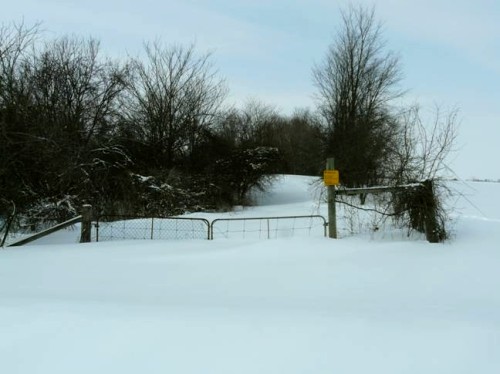
By the end of February, the front gate to MBO was nearly buried; the next snow storm in early March put the snow over the top of it. (Photo by Demetrios Kobiliris)
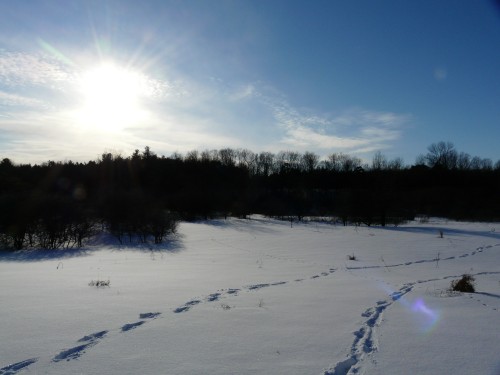
Snowshoe tracks are the only mark on the landscape now that the snow is well over one metre deep across most of MBO (Photo by Demetrios Kobiliris)
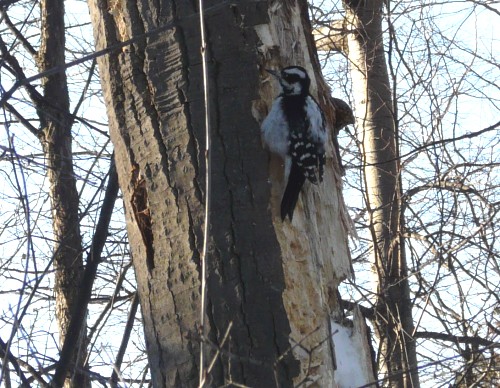
A couple of trees have become favourite feeding spots for the local woodpeckers, including this female Hairy working away at this tree (Photo by Demetrios Kobiliris)
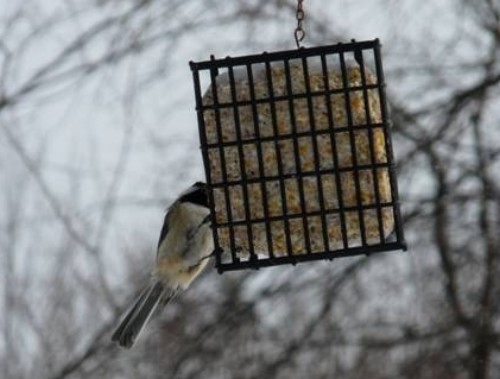
One of our banded Black-capped Chickadees taking advantage of the suet feeder (Photo by Demetrios Kobiliris)
2007-2008 SEASON SUMMARY
| WINTER 2007/08 | OCT/NOV | DEC | JAN | FEB | MAR | TOTAL |
|---|---|---|---|---|---|---|
| Number of days falling within winter season | 31 | 31 | 31 | 29 | 27 | 149 |
| Number of days of observation | 8 | 4 | 5 | 7 | 1 | 25 |
| Number of banding sessions | – | – | – | – | – | – |
| Number of birds (and species) banded | – | – | – | – | – | – |
| Number of birds (and species) repeat | – | – | – | – | – | – |
| Number of birds (and species) return | – | – | – | – | – | – |
| Number of species observed | 36 | 16 | 13 | 17 | 2 | 40 |
| Number of net hours | – | – | – | – | – | – |
| Number of birds banded per 100 net hours | – | – | – | – | – | – |
The winter season at McGill Bird Observatory spans the gap between the fall and spring migration seasons, a total of just over 21 weeks from the last day of October through March 27. Unlike the daily monitoring during migration, activities at MBO in winter are more sporadic, limited largely by weather conditions, especially when it comes to banding. Few other bird observatories this far north are open in winter at all, so even part-time operations can be useful in terms of monitoring the winter occurrence of birds.
The winter of 2007-2008 can be summed up with one word: SNOW – and unfortunately we are not referring to the bander’s acronym for Snowy Owl! Of all the winters we could have picked to forego banding activities, this was the best one to choose! December was one of the snowiest in recent memory, as were January, February and March. As of the end of our official winter season at MBO, the total is just below the all-time record for winter snowfall in Montreal (and there’s still a possibility of an April snowfall putting us over the top). If the volume of snow was not enough, temperatures dipped very low for a few weeks in January and February, making the prospect of walking the census route in -30 Celsius most unappealing.
On the whole, observations were conducted at MBO on 16% of days this winter, down from 30% last year. This reduction is due to difficult weather conditions and the temporary suspension of banding activities.
The winter season actually started off strong with 36 species observed. Though this was down from 42 (2006), there were 10 fewer days of observation. This relatively high number was due to a large number of species hanging around quite late into November (e.g., Yellow-rumped Warbler, Song Sparrow, Great Blue Heron, Eastern Bluebird, and Red-winged Blackbird). As soon as the snow started to accumulate, however, the number of species seen on each census dropped off dramatically, with totals of 16, 13, and 17 species observed in December, January, and February, respectively … not to mention a meager 2 species during the only snowshoe outing managed in March, when the total snow depth was around 1.5 metres (the tops of all the fences were well buried). This is also likely due to the lack of seed in the feeders as well. We decided early on that if we were not going to be banding and were not able to keep the feeders well stocked, that we would not fill them at all. Better for the birds not to get used to a food source only to have it dwindle at a critical time (i.e., right after one of the nine major winter storms when it was virtually impossible for us to even access the site, let alone fill the feeder)!
Overall we ended up with 40 species observed, down from 49 in 2006 – 2007. However, we had about half the number of observation days. If we were to look at the number of species per day of observation, this year would have a much higher value (1.66) than last year (1.06). Despite this higher degree of gratification per visit, censuses this year were hard-going, so we’d like to extend a big thank you to all the dedicated censusers who helped out with the winter program. We hope to have a less snowy and more productive winter season in 2008 / 2009, but in the meantime are looking forward to a great, soggy spring! All the better for waterfowl banding…
Below, for comparison, is the summary table from 2006 / 2007; the entire seasonal report and weekly records can be found in the banding log.
| WINTER 2006/07 | OCT/NOV | DEC | JAN | FEB | MAR | TOTAL |
|---|---|---|---|---|---|---|
| Number of days falling within winter season | 31 | 31 | 31 | 28 | 27 | 148 |
| Number of days of observation | 18 | 7 | 6 | 6 | 9 | 46 |
| Number of banding sessions | 3 | 3 | 2 | — | 3 | 11 |
| Number of birds (and species) banded | 41 (8) | 21 (7) | 14 (4) | — | 24 (7) | 100 (11) |
| Number of birds (and species) repeat | 13 (4) | 8 (3) | 5 (2) | — | 7 (2) | 33 (7) |
| Number of birds (and species) return | 1 (1) | 2 (1) | 2 (1) | — | 2 (2) | 7 (2) |
| Number of species observed | 42 | 33 | 24 | 17 | 28 | 49 |
| Number of net hours | 35.0 | 31.0 | 15.0 | — | 22.0 | 103.0 |
| Number of birds banded per 100 net hours | 117.1 | 67.7 | 93.3 | — | 109.1 | 97.1 |
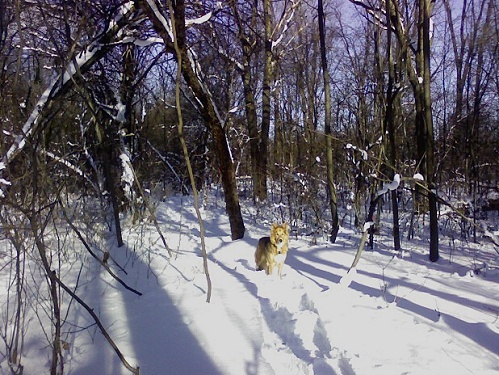 Ordinarily we don’t allow dogs on site to avoid the horrors that domestic animals can sometimes wreak on wildlife, but since we’re not banding this winter, and since she needed to be walked, Daisy was allowed to come along on a path-clearing snowshoe. Those of you who keep track of the weather will realize that this photo was taken in December, but our hands were tied since no photos were taken in November! (Photo by Marie-Anne Hudson)
Ordinarily we don’t allow dogs on site to avoid the horrors that domestic animals can sometimes wreak on wildlife, but since we’re not banding this winter, and since she needed to be walked, Daisy was allowed to come along on a path-clearing snowshoe. Those of you who keep track of the weather will realize that this photo was taken in December, but our hands were tied since no photos were taken in November! (Photo by Marie-Anne Hudson)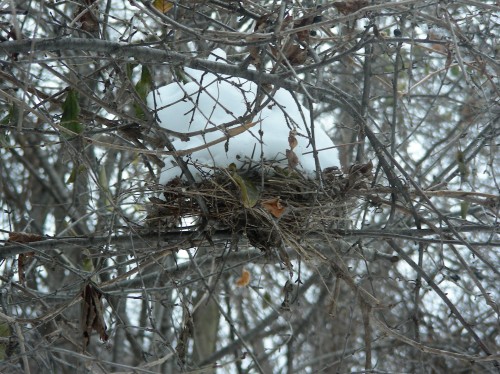 Amidst the snow, this was almost the only sign that birds were ever at MBO! This Northern Cardinal nest was easy to spot with its crown of snow. (Photo by Marie-Anne Hudson)
Amidst the snow, this was almost the only sign that birds were ever at MBO! This Northern Cardinal nest was easy to spot with its crown of snow. (Photo by Marie-Anne Hudson)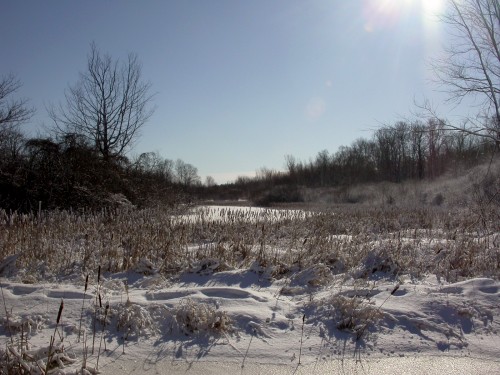 Winter at MBO – a view south over frozen Stoneycroft Pond, from a vantage point beyond the C nets (Photo by Marcel Gahbauer)
Winter at MBO – a view south over frozen Stoneycroft Pond, from a vantage point beyond the C nets (Photo by Marcel Gahbauer)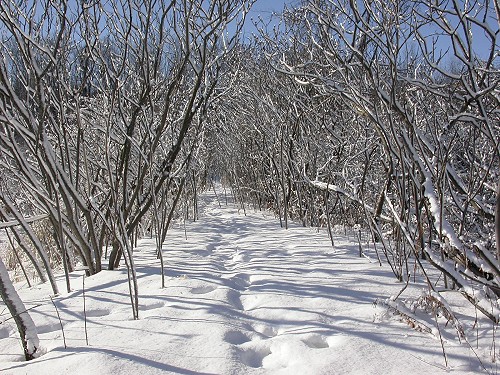 Winter at MBO – the snow in most areas is now over one metre deep, making for some unusual encounters with overhead vegetation when walking along paths such as this one past the C nets (Photo by Marcel Gahbauer)
Winter at MBO – the snow in most areas is now over one metre deep, making for some unusual encounters with overhead vegetation when walking along paths such as this one past the C nets (Photo by Marcel Gahbauer)